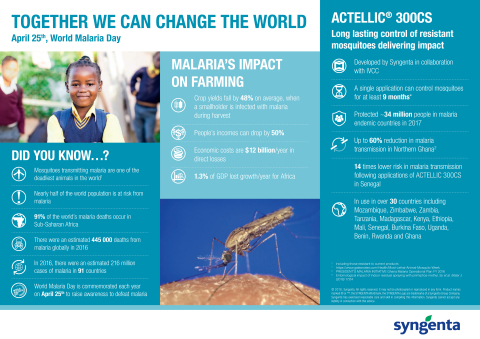Syngenta Announces a New Malaria Insecticide Entering Early Development Phase
Syngenta announced today that a new insecticide active ingredient with a novel mode of action to address resistance in the control of malaria vectors is entering the early development phase. The new ingredient, comes from collaboration between Syngenta and the Innovative Vector Control Consortium (IVCC) to identify and develop new lead areas of novel chemistry suitable for the control of vector mosquitoes. Syngenta and IVCC entered into the collaboration in 2009.
This press release features multimedia. View the full release here: https://www.businesswire.com/news/home/20180418005606/en/

Malaria Facts (Graphic: Business Wire)
The WHO estimated that in 2016 there were 216 million malaria cases in over 90 countries around the world. Malaria is responsible for the death of around 445’000 people each year, and many of those impacted are smallholder farmers. Research shows that when a smallholder is infected with malaria during harvest, crop yields fall by almost 50% and income can drop by 50%.
While yet to be eradicated from many countries, malaria is a preventable and curable disease. Since 2010, improved prevention and control measures have led to a significant reduction in malaria mortality rates globally with success achieved primarily through the use of insecticide treated bed-nets and indoor residual sprays containing pyrethroid insecticides. However, these reductions are under threat due increasing insecticide resistance, reducing the overall effectiveness of vector control programs
To meet this challenge, Syngenta working with the IVCC brought ACTELLIC® 300CS, a mosquito control solution, to the market. In 2013 it received a formal recommendation for use by the World Health Organization and it is estimated that in 2017 this long-lasting control product protected ~34 million people in malaria endemic countries.
Erik Fyrwald, Syngenta CEO said: “With Actellic® 300CS we are achieving remarkable results, but we are fully aware that new solutions are required for sustainable vector control. Our joint effort with IVCC is to discover and develop these solutions which can help to radically transform public health in regions where people live with the daily threat of malaria and to eradicate malaria by 2040. ”
About Syngenta
Syngenta is a leading agriculture company helping to improve global food security by enabling millions of farmers to make better use of available resources. Through world class science and innovative crop solutions, our 28,000 people in over 90 countries are working to transform how crops are grown. We are committed to rescuing land from degradation, enhancing biodiversity and revitalizing rural communities.
To learn more visit www.syngenta.com and www.goodgrowthplan.com. Follow us on Twitter® at www.twitter.com/Syngenta.
Cautionary Statement Regarding Forward-Looking Statements
This document contains forward-looking statements, which can be identified by terminology such as ‘expect’, ‘would’, ‘will’, ‘potential’, ‘plans’, ‘prospects’, ‘estimated’, ‘aiming’, ‘on track’ and similar expressions. Such statements may be subject to risks and uncertainties that could cause the actual results to differ materially from these statements. For Syngenta, such risks and uncertainties include risks relating to legal proceedings, regulatory approvals, new product development, increasing competition, customer credit risk, general economic and market conditions, compliance and remediation, intellectual property rights, implementation of organizational changes, impairment of intangible assets, consumer perceptions of genetically modified crops and organisms or crop protection chemicals, climatic variations, fluctuations in exchange rates and/or commodity prices, single source supply arrangements, political uncertainty, natural disasters, and breaches of data security or other disruptions of information technology. Syngenta assumes no obligation to update forward-looking statements to reflect actual results, changed assumptions or other factors.
View source version on businesswire.com: https://www.businesswire.com/news/home/20180418005606/en/


